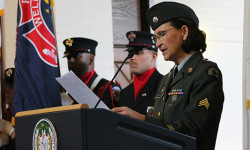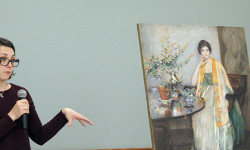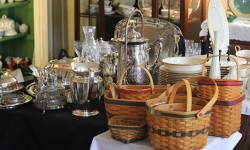[ccfic caption-text format="plaintext"]
By Rama K. Ramaswamy
The Wellesley Historical Society is a nonprofit, founded in 1925. It has resided in a number of locations, including the Town Hall and the Wellesley Hills Branch Library until 1975, when the Dadmun-McNamara House was purchased from the McNamara family for $1 and moved from its location on Rt. 9 to its current location at 229 Washington Street; the house had been built in 1824 by Daniel Dadmun, one of the early toll-keepers on the Worcester Turnpike.
Last weekend, First Vice President John Dirlam and board member Robin Gaynor of the Wellesley Historical Society led a tour of Cottage Street. The tour began in 1650 with John Eliot, who founded a settlement near Lake Waban, learned the Algonquian language and created a written language for the native people; he was dubbed “the Apostle of the Indians.” Dirlam and Gaynor led the way, telling attendees how Wellesley was once West Needham and how George Washington rode through town, grabbing a drink in one of two taverns along present-day Washington St. Minutemen also gathered at these taverns and answered the call to battle to march against the British at Lexington and Concord, where the Revolutionary War began.
The parking lot adjacent to St. Andrews Church once housed the Lovewell shoe factory and Cottage St. used to be called Lovewell Place, marking it as Wellesley’s first historic district in 1980. The Lovewell factory was inherited by Wellesley College, where the college housed students and all their bicycles, even changing its name to Eliot House. Eventually, as St. Andrew’s expanded, a few homes were uprooted and moved. As per the Puritan ethic, rather than tearing them down, they were placed on present-day Cottage St. In fact, if you take a closer look, the front doors of those two historic homes face Washington St. rather than Cottage St.
Proceeding further down Cottage St., Dirlam and Gaynor pointed out a home that once housed the foreman for Lovewell’s factory and another from which three young men went off to fight in the Civil War. Cottage St. exits onto Grove St. and the Dana Hall School, which was founded in 1881 as a preparatory school for Wellesley College. The school was founded by the Durants in 1875, even before Wellesley became incorporated as a town, officially changed its name, and separated from West Needham.
Back along the intersection of Washington St. and Weston Rd., the parking lot now located on the spot once held a four-story tea room called the Noanet, which served vanilla creams to Wellesley College students. Attendees also learned that Weston Rd. was once called Blossom St. in honor of the immaculate, blooming garden belonging to one of the residents along the road. It still houses the historic homes of Isaac Flagg and the widow Morse.
The 90-minute guided tour focused on a theme of how roads, railways, and other transportation methods shaped the development of Wellesley.
The Wellesley Historical Society offers a variety of programs and lecture, to support or get more information, go to: www.wellesleyhistoricalsociety.org/programs






















